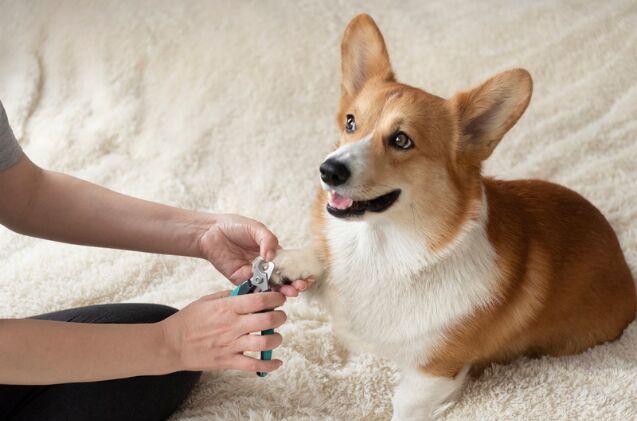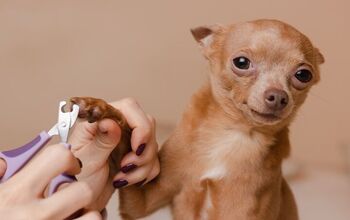What Should I Do If My Dog is Afraid of Nail Trims?

The dreaded nail clippers – a source of stress and occasional doggy drama in our home as well as for many dog parents. You see, our youngest pup, Lucifer, and I have been on quite the journey to conquer his fear of nail trimming. If you’ve ever found yourself in a similar situation, you know the struggle all too well!
But fear not, because in this article, I’m sharing our personal tale of progress and a toolkit of tips we’ve picked up along the way to help overcome your dog’s fear of nail clipping.
So, let’s swap nail-trimming anxiety for confidence and cooperation, one paw at a time.
Why Does My Dog Hate Nail Trims?
The first step to overcoming a fear of nail trims is understanding why the sight of nail clippers is a source of anxiety for your dog. After all, the clippers themselves aren’t frightening or intimidating.
For many dogs, the fear of having their nails cut is rooted in a desire to protect their paws. This is a survival instinct, as they need their paws to survive in the wild, both to escape predators and be able to catch food. They haven’t been taught that the process of having their nails cut or their paws handled isn’t going to cause harm.
If your dog was previously okay with having their nails trimmed and suddenly changes their mind and lashes out when you try, this is a sign of trouble. Have you recently cut your dog`s nail and accidentally nicked the quick of the nail? If so, your dog may associate the experience with the pain and discomfort they felt at that moment.
This could also indicate that your dog feels pain in their leg or paw. Watch for other signs of distress or discomfort, like lameness, limping, or excessively licking the area. If you suspect your dog is in pain or if your dog has shown a behavior change that you can’t otherwise explain, contact your veterinarian. They can run the tests necessary to help diagnose the problem and recommend ways to provide effective pain relief.
For us, with Lucifer, we are overcoming a reaction due to previous pain. He suffered injuries to his front paws before he was rescued and adopted out to us as a puppy. While we have worked with specialists to help him heal and move on from these injuries, he is still more protective of his paws and dislikes having them handled.
What Happens if You Wait Too Long to Cut Dog Nails?
Keeping your dog’s nails trimmed and cared for is an integral part of grooming. How often you need to trim their nails will vary, depending on their breed, age, and lifestyle. Some dogs will naturally wear down their nails from walking and running on rough surfaces, as they would in the wild, while others don’t engage in these activities frequently enough to keep up with nail growth.
When a dog’s nails become overgrown, they interfere with their ability to stand and walk properly, reducing traction and potentially causing injuries in their feet and tendons. This is because the nails contact the floor before their paw pads. Over time, this can also lead to long-term injuries, deformities in the paw or leg, or arthritis. This can also cause older dogs to slip and fall due to losing traction and unsteadiness on their feet.
How Do Vets Cut Aggressive Dogs’ Nails?
One of the first recommendations you will hear when mentioning that your dog is resistant to having their nails trimmed is to bring them to a professional, like a groomer or veterinarian. But how do they overcome a dog’s reactivity or aggression to cut their nails effectively?
For some “difficult dogs,” the secret to getting their nails trimmed is simply a matter of skill and experience. These professionals have a lot of practice cutting dog nails, allowing them to go through the motions faster and more effectively than most dog parents can at home. By speeding up the process, they can sometimes get through it before a dog becomes too agitated. They may also have tricks to help your dog feel secure or make the nail trim more comfortable.
Unfortunately, this isn’t enough for every dog. Some dogs will lash out aggressively when nail clippers are brought near them. Your dog may have to be sedated for their nail trim in these situations.
How Do I Train My Dog to Tolerate Nail Trimming?
For many dogs, the ability to tolerate a nail trim is a skill that can be taught with patience and conditioning. It is recommended that you start this process as soon as you bring your puppy home, setting them up for success for years to come. But you can also work with an older dog to help them overcome fear and anxiety triggered by nail trims.
Step One – Paw Handling
Teaching your dog to be okay with having their nails cut starts without any tools at all – just you and your dog. This first step focuses on helping them feel comfortable with having someone touching or holding their paws. This isn’t a concern for some dogs – especially if you have purchased a dog from a reputable breeder who has dedicated time to introducing touch and handling at a young age. But some dogs are very protective of their paws, as our boy Lucifer was when he came to us.
Don’t jump right into grabbing your dog’s paw, or it could set them off and lead to a bite. Instead, start gently touching their shoulder and leg. Speak calmly and watch for any sign that they are uncomfortable. As their comfort allows, slowly work closer to their paw until they are comfortable with you petting or holding their paw. You can offer treats for allowing you to touch their paws to create a positive association.
With Lucifer, we also combined this process with the “Shake” command – as he was comfortable with that, but not when we held his paw. We would ask him to shake, rewarding him when his paw landed in our hand, and we held it. Over time, we increased the time we could hold it.
When your dog is comfortable with you holding their paw, try touching or putting pressure on the toes. Like the paw, don’t rush this… Take your time, observe your dog’s body language, and allow them to guide how quickly you move through the process.
Step Two – Introduce the Nail Clippers
When introducing the nail clippers, don’t try to use them or even bring them near your dog’s nails. Instead, place them on the floor to allow your pup to check them out at their own pace. When your dog has had sufficient time to sniff them and become comfortable with them being around, pick them up in your dog’s presence. When you do, praise and reward your dog before placing them back down again. It won’t take long for most dogs to associate you picking up the nail clippers with good things.
Step Three – Combine the Two
When your dog gets visibly excited at the sight of you picking up the clippers, it is time to combine the clippers and the paw handling you did in step one. Sit on the floor and call your dog over to you, petting them and showing them that you are happy to see them. When you can see your dog is relaxed and comfortable enough to do some training, handle their paw as you did to start this, either by asking for a “shake” or simply picking their paw up.
With the paw in one hand, pick up the clippers and move them closer to your dog’s paw before placing them back on the ground and offering praise and a reward. Repeat this, moving the clippers closer to your dog’s paw until you can gently touch them to their nail without causing a stress reaction.
Step Four – Time to Trim
The first time you trim a nail, don’t push too far. You don’t need to cut all their nails or even all their nails on a single paw. Instead, start with cutting just the tip off one nail before rewarding and praising them. This is introducing a new sensation with the feel of the nail clippers cutting through the nail that they must get used to. If your dog becomes nervous or agitated, stop after one nail.
When your dog is comfortable trimming one nail, try two… then three... then one complete paw. This process can take a long time, but don’t rush it! Pushing your dog too far or fast at this stage could set you back to the beginning again by tarnishing the positive association you built with the nail clippers. If you slowly work it up, you will be cutting all their nails without incident before long.
3 Alternatives to Trimming Your Dog’s Nails
Use a Grinder or Dremel Tool
The most common alternative for nail clippers is a nail grinder. This works by grinding down the nail with a surface like sandpaper, eliminating the clipping action that upsets some dogs. Nail grinders are also an excellent option for dog parents concerned about cutting too much off the nail and catching the quick as they slowly file or grind back the nail.
Just like clippers, you must slowly introduce the nail grinder to your dog. Returning to the above steps, you will need to start with paw handling, bring out the grinder, turn it on so they can get used to the sound it makes, and then move on to combining the grinder with paw handling.
Try a Nail Board
If the sound and sensation of the nail grinder are too much for your dog, you can try manually filing their nails down with a nail board. You can purchase a product like the FearNotNails Dog Nail Scratch Board or build your own DIY nail board using a board and sandpaper.
To teach your dog to use the nail board, try asking them to "shake" while holding it in front of you. When their paw touches the board, praise and reward. From here, you can focus on encouraging them to run their paw down the board, introducing a command like “scratch.” If they are hesitant, try placing the treat under the board so they instinctually dig to get at it.
Teaching your dog to use the nail board on their back legs is a little more challenging. Try setting up the board against a couch or bed, having them stand with their front paws on the furniture and their back paws on or in front of the board. Use the same command you used with the front paw so that they recognize that scratching will result in a treat.
This is the solution we currently use with Lucifer. However, we are still working on slowly conditioning him with traditional nail clippers. The nail scratch board is excellent for filing down the main nails on each paw, but it is tough to target the dew claw.
Visit a Professional
As we previously mentioned, visiting a professional may be the best solution. The goal is to keep your dog’s nails trimmed safely with as little stress and anxiety as possible. Sometimes, the best thing we can do is ask for help. There is always the possibility that, after a few visits, your dog will recognize the nail trim isn’t a frightening experience, and you can work up to cutting their nails at home.
Final Thoughts – Helping a Dog Afraid of Nail Trims
Keeping your dog’s nails trimmed is essential for their health and well-being, but it’s not always easy. For dogs that weren’t introduced to handling as a young puppy, the experience of having someone touch their paw can be uncomfortable or stressful. To overcome this, focus on slowly introducing handling and your tool of choice – nail clippers, a nail grinder, or a nail scratch board.
If you have tried caring for your dog’s nails at home and worry that it can’t be done safely or comfortably (for both you and your dog), consider contacting a professional. In the most severe cases, your vet may need to sedate your dog to take care of their nails effectively.
Each solution has pros and cons, and there is no one-size-fits-all solution. The most important thing is to ensure that your dog receives the care they need, regardless of which solution you find works best for both of you.

Britt Kascjak is a proud pet mom, sharing her heart (and her home) with her “pack” which includes her husband John, their 2 dogs – Indiana and Lucifer – and their 2 cats – Pippen and Jinx. She has been active in the animal rescue community for over 15 years, volunteering, fostering and advocating for organizations across Canada and the US. In her free time, she enjoys traveling around the country camping, hiking, and canoeing with her pets.
More by Britt
























